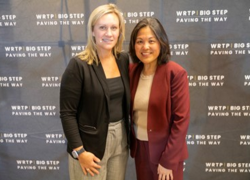
As part of the Good Jobs Initiative, the U.S. Department of Labor helps other federal agencies improve equity and job quality through formal partnerships. And through these partnerships, we’ve learned that there is no one-size-fits-all approach to creating equitable pathways to good jobs.
That’s because every agency has its own unique advantages to incentivizing better jobs and equitable workforce outcomes. Every federal funding program is authorized by different laws, with different limitations and advantages based on how Congress drafted those laws. As part of the Good Jobs Initiative, we’re working with agencies to explore to what extent they can implement our recommended policies.
Improving Job Quality in Funding Opportunities
One important way we’re partnering with other agencies such as the departments of Commerce, Energy and Transportation to advance equity is by working with them to embed innovative language in their Notices of Funding Opportunity, as well as in their guidance to grantees and stakeholders, that prioritizes the quality of jobs – not just job creation.
The markers of job quality include paying family-sustaining wages and benefits, employment practices free from discrimination and harassment, and a free and fair choice to join a union. By emphasizing job quality, we can help increase access to good jobs among historically marginalized workers, such as people of color, women, veterans, individuals with disabilities, workers from rural communities, individuals involved in the justice system and those reentering the workforce.
For example, the 2022 Department of Transportation’s Rebuilding American Infrastructure with Sustainability and Equity (RAISE) grant judged applicants in part based on whether they “offer[ed] significant regional and national improvements in economic strength” by creating good paying jobs, increasing access to jobs for disadvantaged communities, or implementing the use of local hire agreements or registered apprenticeship. Using these strategies gave funding applicants a chance to be more competitive.
Similarly, the fiscal year 2022 Department of Commerce’s Broadband Equity, Access, and Deployment (BEAD) Program grant judged applicants on three sets of criteria (primary, secondary and additional). The application asked applicants for their demonstrated record of compliance with federal labor laws or plans to reach compliance. The grant opportunity also encouraged applicants to enforce commitments to advancing equitable workforce development and job quality, open access, and garnering support from local and tribal governments.
In the Transportation Department’s RAISE grant, applicants who committed to job quality and equity were able to successfully meet one of the required criteria, receive a higher score, and be more likely to be awarded the discretionary grant funding. Similarly, in the Commerce Department’s BEAD grant, applicants will need to demonstrate specified commitments to job quality and equity to access the formula grant funds. While both grants drove toward the same outcome, the approach taken was unique to the structure, demands and requirements of each program.
Other entities can learn from these efforts. States, tribes, cities, localities, employers and other entities should consider the following:
Creating formal structures to support inter-governmental and whole-of-government collaboration. This type of collaboration creates communication channels and practice sharing in support of good jobs for all workers.
Taking a flexible approach to the incentive methods through which they promote job quality and equity.
Leveraging their authorities to require, preference or encourage policies proven to lead to improved job quality and equity outcomes. Such policies could include the use of project labor agreements, labor peace agreements, pre-apprenticeship programs, and registered apprenticeship programs, etc.
There is also opportunity for other interested parties like community organizations to study the efficacy of the incentives described above. As this work continues, the need for outcome assessment will grow to hone the very best practices for successful creation of good jobs and equity.
For more information about policy tools that support improved job quality and equity, check out these resources:
This blog series was a collaborative effort by the Good Jobs Initiative, Women's Bureau, and the Office of Federal Contracting Compliance Programs. A special thanks to the Office of Disability Employment Policy, the Employment and Training Administration, and the Veterans’ Employment and Training Service.
Editor’s note: This blog post is part of a series on the Good Jobs Initiative. Read the other posts here:
- Leveraging Federal Dollars to Create Good Jobs
- There’s No One-Size-Fits-All Approach to Advancing Job Quality and Equity
- Creating More Equitable Pathways to Good Jobs
- Data is the Cornerstone of an Equitable Jobs Strategy
- Building an Equitable Workforce Requires Partnerships at Every Level
This document contains links to information created and maintained by other public and private organizations. Please be aware that the U.S. Dept. of Labor does not control or guarantee the accuracy, relevance, timeliness, or completeness of this outside information. Further, the inclusion of links to particular items is not intended to reflect their importance, nor is it intended to endorse any views expressed or products or services offered by the author of the reference or the organization operating the site on which the reference is maintained.

 U.S. Department of Labor Blog
U.S. Department of Labor Blog
